AirAsia Case Study: Navigating Challenges in China's Airline Industry
VerifiedAdded on 2021/05/31
|7
|1221
|37
Case Study
AI Summary
This case study analyzes the key issues faced by AirAsia in the Chinese market. The study begins with an introduction to the challenges faced by low-cost carriers (LCCs) in the airline industry, particularly focusing on regulatory measures imposed by the Chinese government. It explores the impacts ...
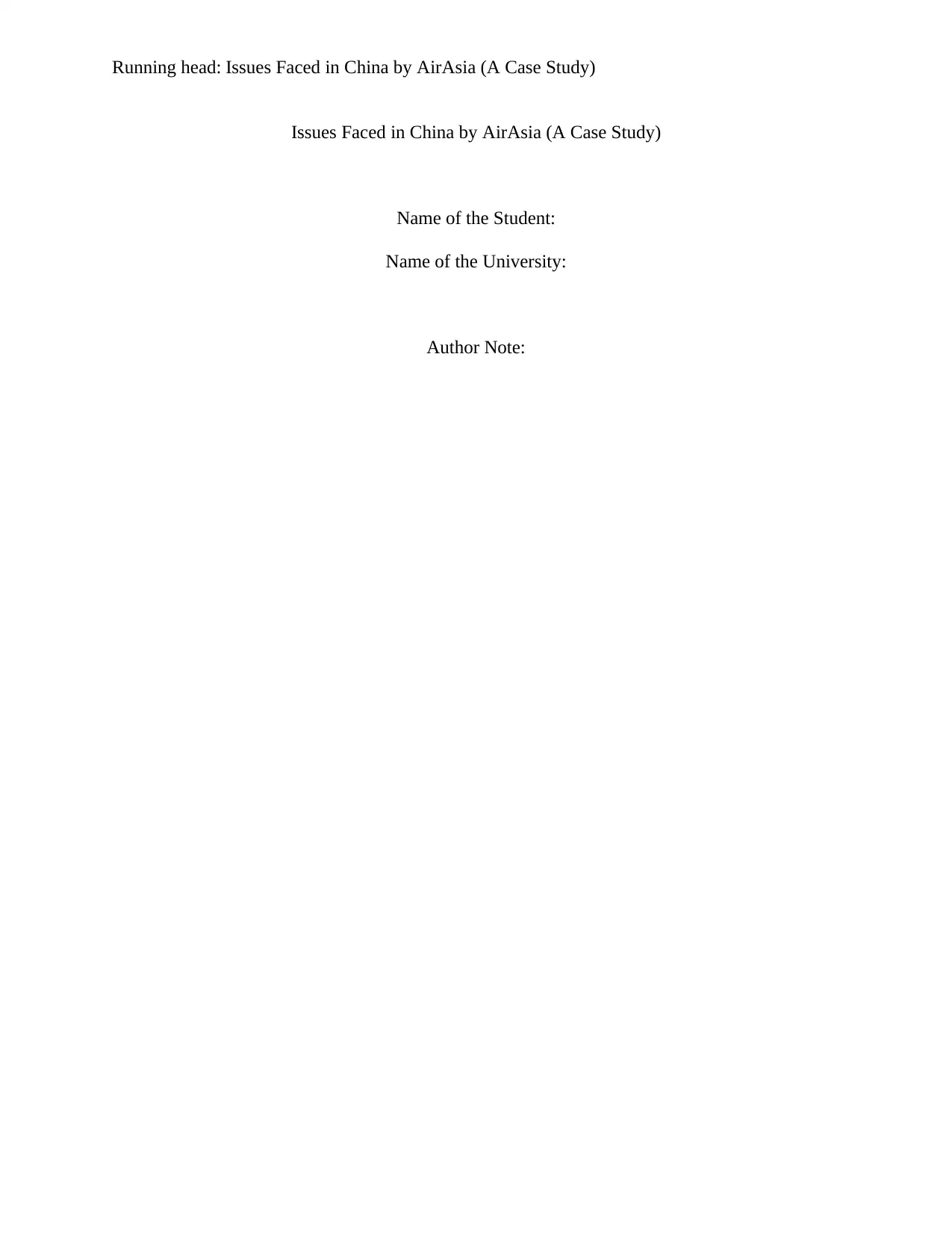
Running head: Issues Faced in China by AirAsia (A Case Study)
Issues Faced in China by AirAsia (A Case Study)
Name of the Student:
Name of the University:
Author Note:
Issues Faced in China by AirAsia (A Case Study)
Name of the Student:
Name of the University:
Author Note:
Paraphrase This Document
Need a fresh take? Get an instant paraphrase of this document with our AI Paraphraser
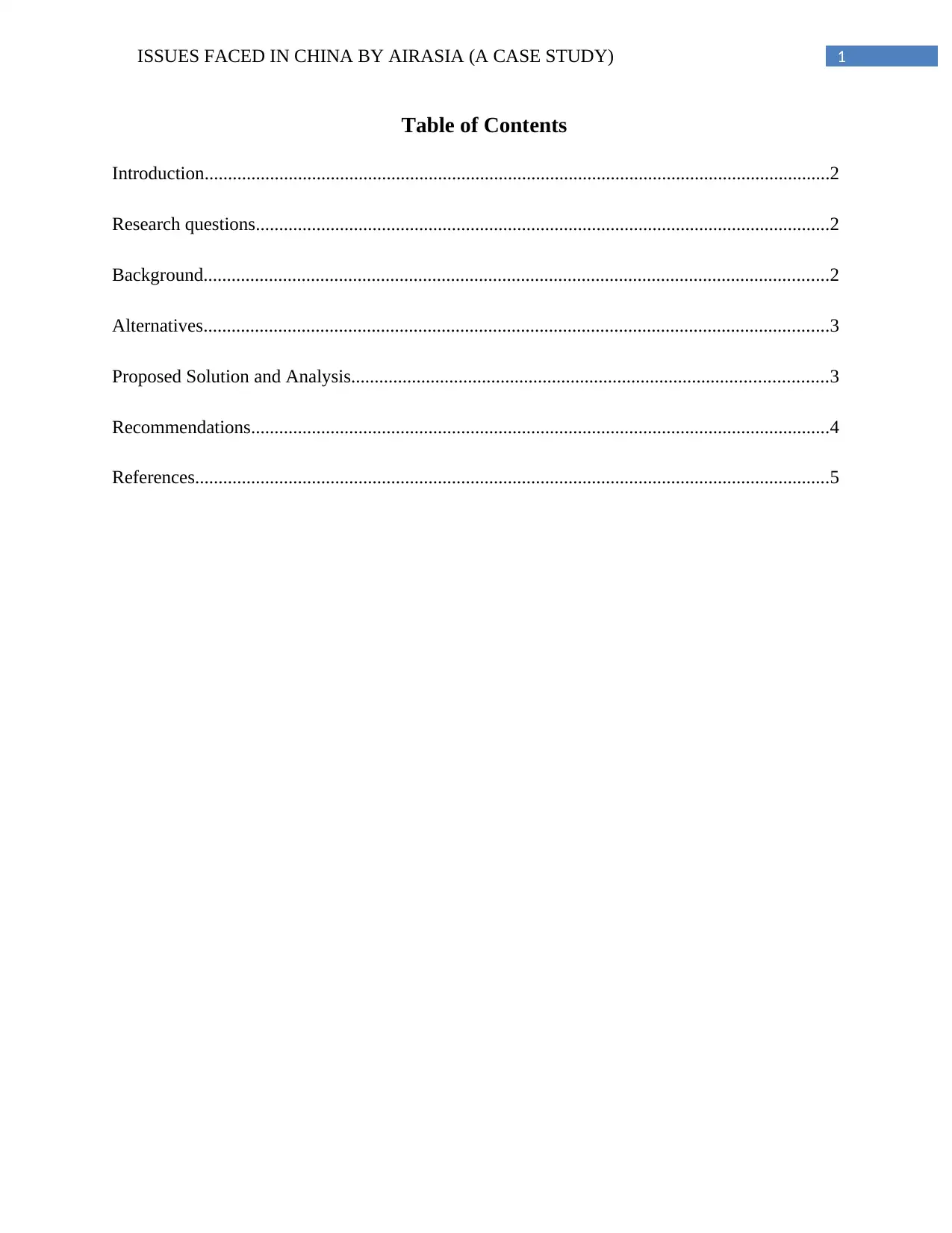
1ISSUES FACED IN CHINA BY AIRASIA (A CASE STUDY)
Table of Contents
Introduction......................................................................................................................................2
Research questions...........................................................................................................................2
Background......................................................................................................................................2
Alternatives......................................................................................................................................3
Proposed Solution and Analysis......................................................................................................3
Recommendations............................................................................................................................4
References........................................................................................................................................5
Table of Contents
Introduction......................................................................................................................................2
Research questions...........................................................................................................................2
Background......................................................................................................................................2
Alternatives......................................................................................................................................3
Proposed Solution and Analysis......................................................................................................3
Recommendations............................................................................................................................4
References........................................................................................................................................5
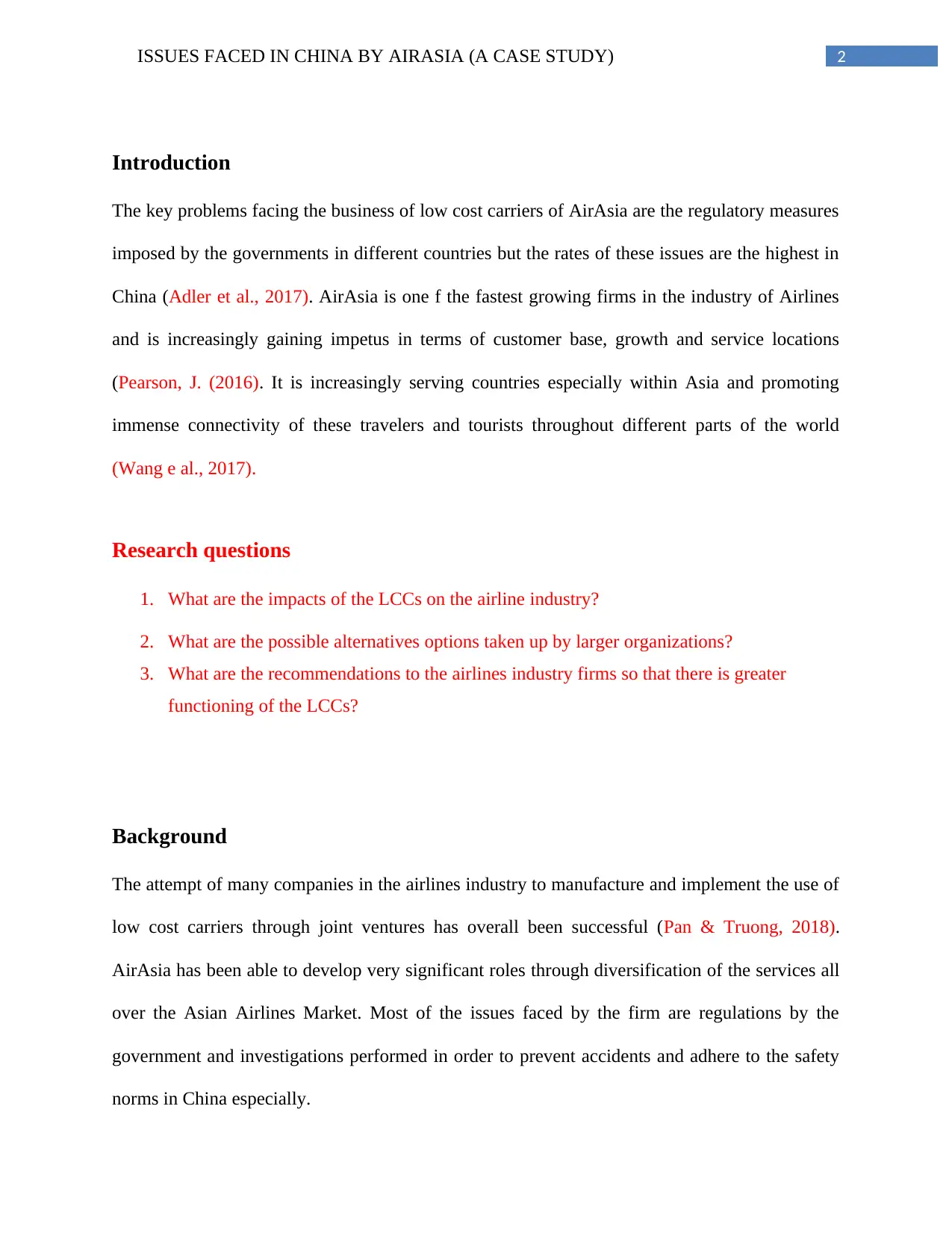
2ISSUES FACED IN CHINA BY AIRASIA (A CASE STUDY)
Introduction
The key problems facing the business of low cost carriers of AirAsia are the regulatory measures
imposed by the governments in different countries but the rates of these issues are the highest in
China (Adler et al., 2017). AirAsia is one f the fastest growing firms in the industry of Airlines
and is increasingly gaining impetus in terms of customer base, growth and service locations
(Pearson, J. (2016). It is increasingly serving countries especially within Asia and promoting
immense connectivity of these travelers and tourists throughout different parts of the world
(Wang e al., 2017).
Research questions
1. What are the impacts of the LCCs on the airline industry?
2. What are the possible alternatives options taken up by larger organizations?
3. What are the recommendations to the airlines industry firms so that there is greater
functioning of the LCCs?
Background
The attempt of many companies in the airlines industry to manufacture and implement the use of
low cost carriers through joint ventures has overall been successful (Pan & Truong, 2018).
AirAsia has been able to develop very significant roles through diversification of the services all
over the Asian Airlines Market. Most of the issues faced by the firm are regulations by the
government and investigations performed in order to prevent accidents and adhere to the safety
norms in China especially.
Introduction
The key problems facing the business of low cost carriers of AirAsia are the regulatory measures
imposed by the governments in different countries but the rates of these issues are the highest in
China (Adler et al., 2017). AirAsia is one f the fastest growing firms in the industry of Airlines
and is increasingly gaining impetus in terms of customer base, growth and service locations
(Pearson, J. (2016). It is increasingly serving countries especially within Asia and promoting
immense connectivity of these travelers and tourists throughout different parts of the world
(Wang e al., 2017).
Research questions
1. What are the impacts of the LCCs on the airline industry?
2. What are the possible alternatives options taken up by larger organizations?
3. What are the recommendations to the airlines industry firms so that there is greater
functioning of the LCCs?
Background
The attempt of many companies in the airlines industry to manufacture and implement the use of
low cost carriers through joint ventures has overall been successful (Pan & Truong, 2018).
AirAsia has been able to develop very significant roles through diversification of the services all
over the Asian Airlines Market. Most of the issues faced by the firm are regulations by the
government and investigations performed in order to prevent accidents and adhere to the safety
norms in China especially.
⊘ This is a preview!⊘
Do you want full access?
Subscribe today to unlock all pages.

Trusted by 1+ million students worldwide
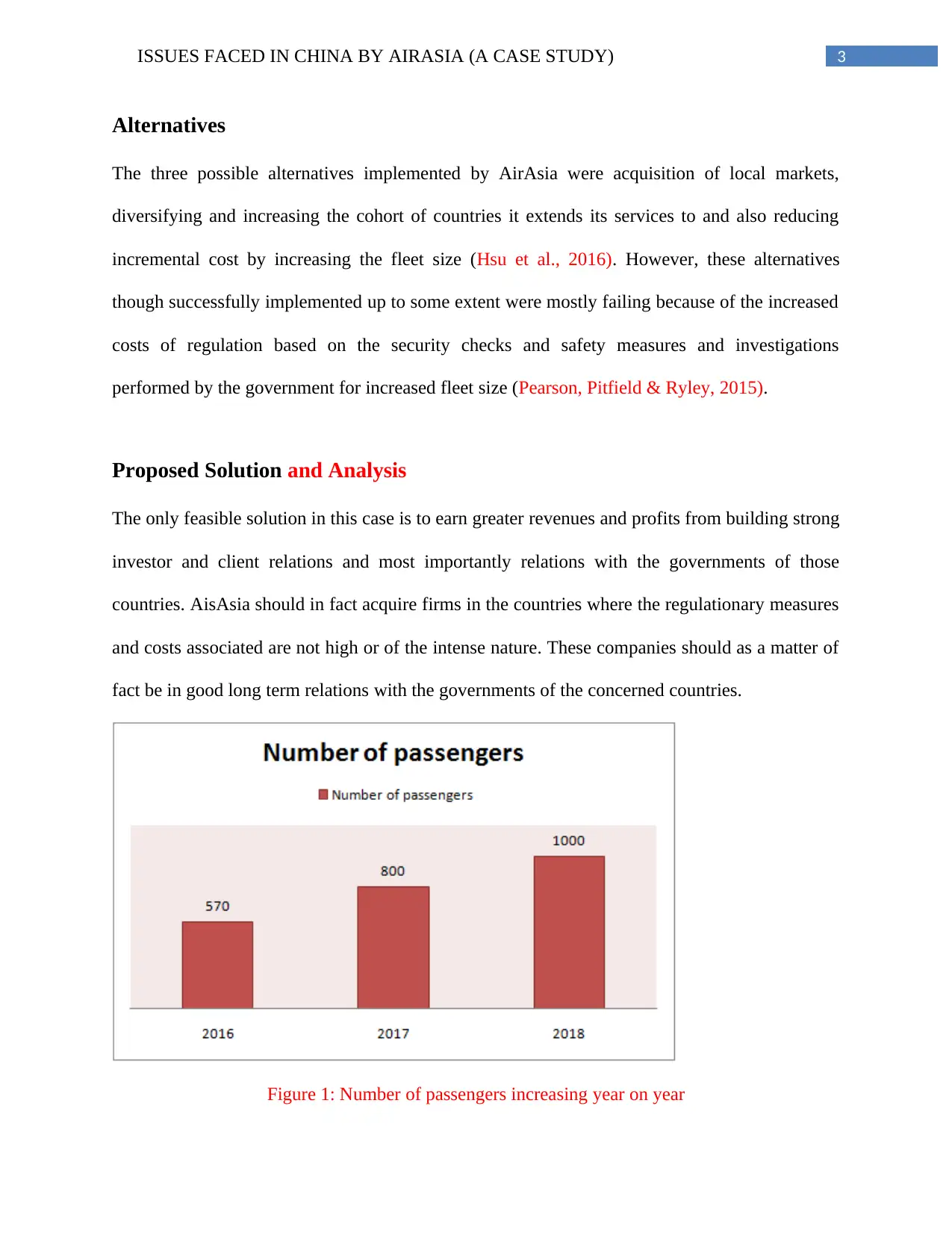
3ISSUES FACED IN CHINA BY AIRASIA (A CASE STUDY)
Alternatives
The three possible alternatives implemented by AirAsia were acquisition of local markets,
diversifying and increasing the cohort of countries it extends its services to and also reducing
incremental cost by increasing the fleet size (Hsu et al., 2016). However, these alternatives
though successfully implemented up to some extent were mostly failing because of the increased
costs of regulation based on the security checks and safety measures and investigations
performed by the government for increased fleet size (Pearson, Pitfield & Ryley, 2015).
Proposed Solution and Analysis
The only feasible solution in this case is to earn greater revenues and profits from building strong
investor and client relations and most importantly relations with the governments of those
countries. AisAsia should in fact acquire firms in the countries where the regulationary measures
and costs associated are not high or of the intense nature. These companies should as a matter of
fact be in good long term relations with the governments of the concerned countries.
Figure 1: Number of passengers increasing year on year
Alternatives
The three possible alternatives implemented by AirAsia were acquisition of local markets,
diversifying and increasing the cohort of countries it extends its services to and also reducing
incremental cost by increasing the fleet size (Hsu et al., 2016). However, these alternatives
though successfully implemented up to some extent were mostly failing because of the increased
costs of regulation based on the security checks and safety measures and investigations
performed by the government for increased fleet size (Pearson, Pitfield & Ryley, 2015).
Proposed Solution and Analysis
The only feasible solution in this case is to earn greater revenues and profits from building strong
investor and client relations and most importantly relations with the governments of those
countries. AisAsia should in fact acquire firms in the countries where the regulationary measures
and costs associated are not high or of the intense nature. These companies should as a matter of
fact be in good long term relations with the governments of the concerned countries.
Figure 1: Number of passengers increasing year on year
Paraphrase This Document
Need a fresh take? Get an instant paraphrase of this document with our AI Paraphraser
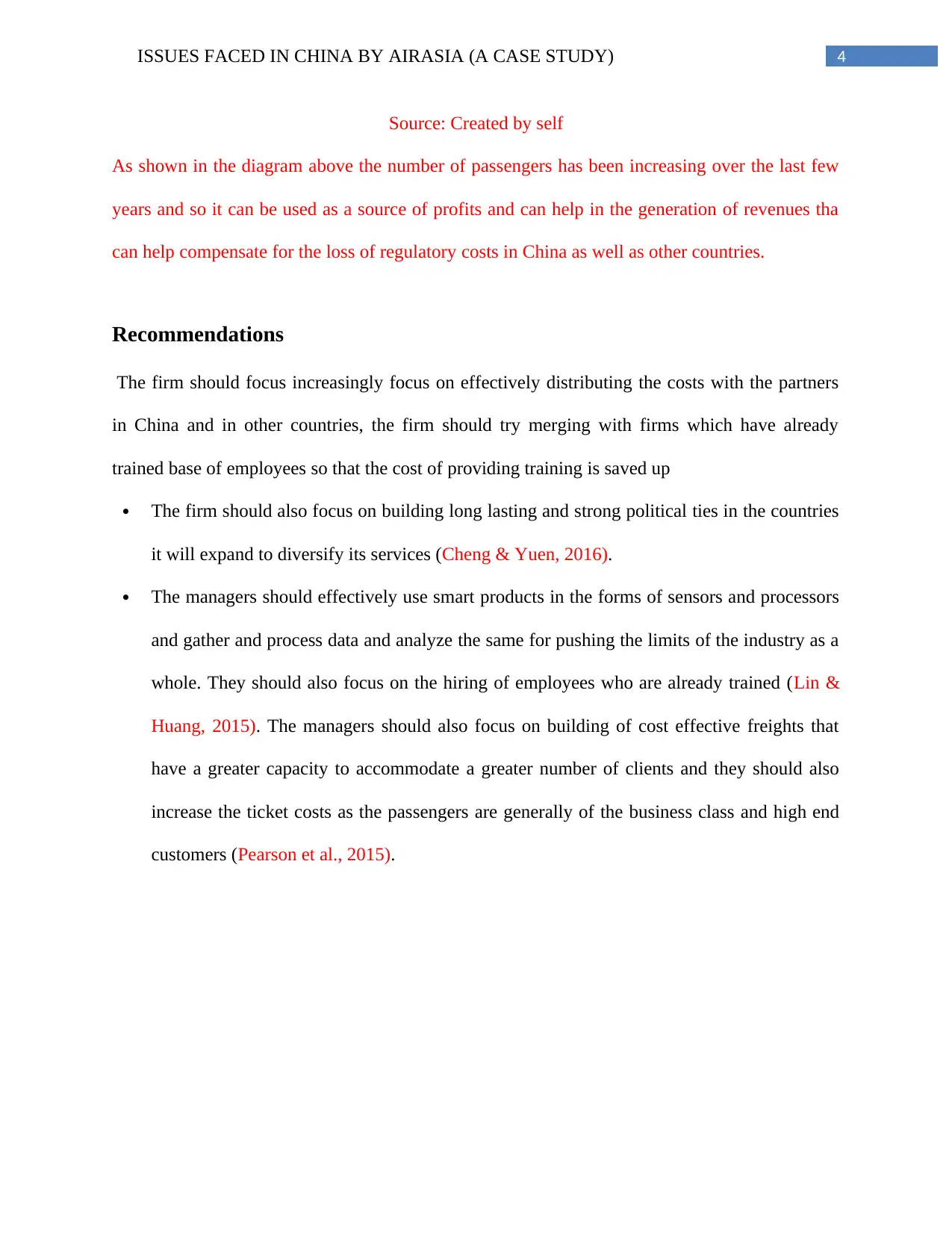
4ISSUES FACED IN CHINA BY AIRASIA (A CASE STUDY)
Source: Created by self
As shown in the diagram above the number of passengers has been increasing over the last few
years and so it can be used as a source of profits and can help in the generation of revenues tha
can help compensate for the loss of regulatory costs in China as well as other countries.
Recommendations
The firm should focus increasingly focus on effectively distributing the costs with the partners
in China and in other countries, the firm should try merging with firms which have already
trained base of employees so that the cost of providing training is saved up
The firm should also focus on building long lasting and strong political ties in the countries
it will expand to diversify its services (Cheng & Yuen, 2016).
The managers should effectively use smart products in the forms of sensors and processors
and gather and process data and analyze the same for pushing the limits of the industry as a
whole. They should also focus on the hiring of employees who are already trained (Lin &
Huang, 2015). The managers should also focus on building of cost effective freights that
have a greater capacity to accommodate a greater number of clients and they should also
increase the ticket costs as the passengers are generally of the business class and high end
customers (Pearson et al., 2015).
Source: Created by self
As shown in the diagram above the number of passengers has been increasing over the last few
years and so it can be used as a source of profits and can help in the generation of revenues tha
can help compensate for the loss of regulatory costs in China as well as other countries.
Recommendations
The firm should focus increasingly focus on effectively distributing the costs with the partners
in China and in other countries, the firm should try merging with firms which have already
trained base of employees so that the cost of providing training is saved up
The firm should also focus on building long lasting and strong political ties in the countries
it will expand to diversify its services (Cheng & Yuen, 2016).
The managers should effectively use smart products in the forms of sensors and processors
and gather and process data and analyze the same for pushing the limits of the industry as a
whole. They should also focus on the hiring of employees who are already trained (Lin &
Huang, 2015). The managers should also focus on building of cost effective freights that
have a greater capacity to accommodate a greater number of clients and they should also
increase the ticket costs as the passengers are generally of the business class and high end
customers (Pearson et al., 2015).

5ISSUES FACED IN CHINA BY AIRASIA (A CASE STUDY)
References
Adler, R., Stringer, C., Shantripriyan, P., Birch, M. G., & Tohmatsu, D. T. (2017). AirAsia:
Towards a ‘new world’carrier strategy and implications for performance management
system design.
Barreveld, D. (2015). Air Crash Investigations-Cracked Solder Joint-The Crash of Indonesia Air
Asia Flight 8501. Lulu Press, Inc.
Bjelicic, B., 2012. Financing airlines in the wake of the financial markets crisis. Journal of Air
Transport Management, 21, pp.10-16.
Cheng, T. C., & Yuen, A. (2016). Exploring The Potential of Asian Low Cost Carriers Forming
Strategic Alliances.
Hsu, C. J., Yen, J. R., Chang, Y. C., & Woon, H. K. (2016). How do the services of low cost
carriers affect passengers' behavioral intentions to revisit a destination?. Journal of Air
Transport Management, 52, 111-116.
Lee, J.W. and Dy, M., 2015. Mitigating ‘Effective Control’Restriction on Joint Venture Airlines
in Asia: Philippine AirAsia Case. Air and Space Law, 40(3), pp.231-253.
Lin, H. F., & Huang, Y. W. (2015). Using analytic network process to measure the determinants
of low cost carriers purchase intentions: A comparison of potential and current
customers. Journal of Air Transport Management, 49, 9-16
Pan, J. Y., & Truong, D. (2018). Passengers’ intentions to use low-cost carriers: An extended
theory of planned behavior model. Journal of Air Transport Management, 69, 38-48.
References
Adler, R., Stringer, C., Shantripriyan, P., Birch, M. G., & Tohmatsu, D. T. (2017). AirAsia:
Towards a ‘new world’carrier strategy and implications for performance management
system design.
Barreveld, D. (2015). Air Crash Investigations-Cracked Solder Joint-The Crash of Indonesia Air
Asia Flight 8501. Lulu Press, Inc.
Bjelicic, B., 2012. Financing airlines in the wake of the financial markets crisis. Journal of Air
Transport Management, 21, pp.10-16.
Cheng, T. C., & Yuen, A. (2016). Exploring The Potential of Asian Low Cost Carriers Forming
Strategic Alliances.
Hsu, C. J., Yen, J. R., Chang, Y. C., & Woon, H. K. (2016). How do the services of low cost
carriers affect passengers' behavioral intentions to revisit a destination?. Journal of Air
Transport Management, 52, 111-116.
Lee, J.W. and Dy, M., 2015. Mitigating ‘Effective Control’Restriction on Joint Venture Airlines
in Asia: Philippine AirAsia Case. Air and Space Law, 40(3), pp.231-253.
Lin, H. F., & Huang, Y. W. (2015). Using analytic network process to measure the determinants
of low cost carriers purchase intentions: A comparison of potential and current
customers. Journal of Air Transport Management, 49, 9-16
Pan, J. Y., & Truong, D. (2018). Passengers’ intentions to use low-cost carriers: An extended
theory of planned behavior model. Journal of Air Transport Management, 69, 38-48.
⊘ This is a preview!⊘
Do you want full access?
Subscribe today to unlock all pages.

Trusted by 1+ million students worldwide
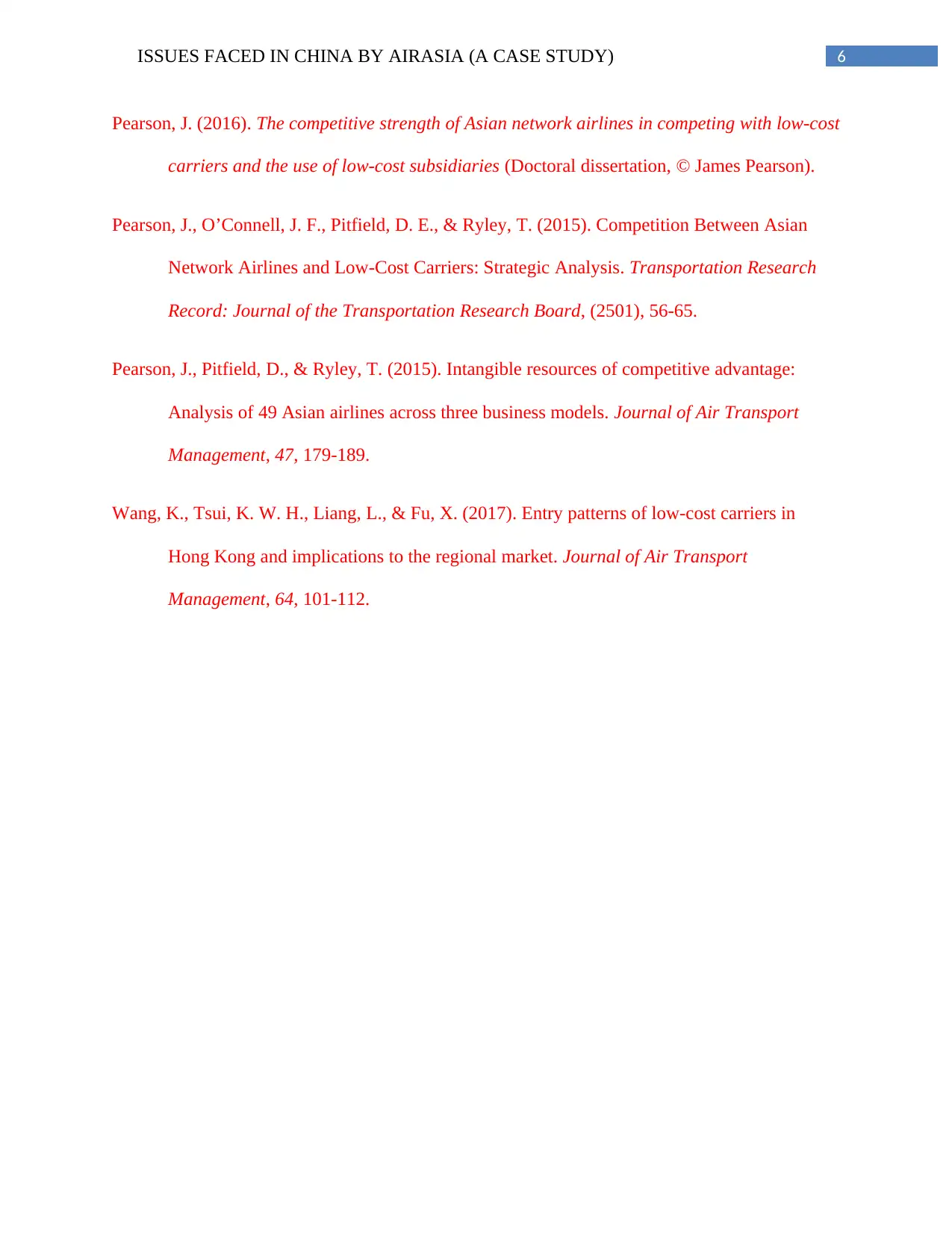
6ISSUES FACED IN CHINA BY AIRASIA (A CASE STUDY)
Pearson, J. (2016). The competitive strength of Asian network airlines in competing with low-cost
carriers and the use of low-cost subsidiaries (Doctoral dissertation, © James Pearson).
Pearson, J., O’Connell, J. F., Pitfield, D. E., & Ryley, T. (2015). Competition Between Asian
Network Airlines and Low-Cost Carriers: Strategic Analysis. Transportation Research
Record: Journal of the Transportation Research Board, (2501), 56-65.
Pearson, J., Pitfield, D., & Ryley, T. (2015). Intangible resources of competitive advantage:
Analysis of 49 Asian airlines across three business models. Journal of Air Transport
Management, 47, 179-189.
Wang, K., Tsui, K. W. H., Liang, L., & Fu, X. (2017). Entry patterns of low-cost carriers in
Hong Kong and implications to the regional market. Journal of Air Transport
Management, 64, 101-112.
Pearson, J. (2016). The competitive strength of Asian network airlines in competing with low-cost
carriers and the use of low-cost subsidiaries (Doctoral dissertation, © James Pearson).
Pearson, J., O’Connell, J. F., Pitfield, D. E., & Ryley, T. (2015). Competition Between Asian
Network Airlines and Low-Cost Carriers: Strategic Analysis. Transportation Research
Record: Journal of the Transportation Research Board, (2501), 56-65.
Pearson, J., Pitfield, D., & Ryley, T. (2015). Intangible resources of competitive advantage:
Analysis of 49 Asian airlines across three business models. Journal of Air Transport
Management, 47, 179-189.
Wang, K., Tsui, K. W. H., Liang, L., & Fu, X. (2017). Entry patterns of low-cost carriers in
Hong Kong and implications to the regional market. Journal of Air Transport
Management, 64, 101-112.
1 out of 7
Related Documents
Your All-in-One AI-Powered Toolkit for Academic Success.
+13062052269
info@desklib.com
Available 24*7 on WhatsApp / Email
![[object Object]](/_next/static/media/star-bottom.7253800d.svg)
Unlock your academic potential
© 2024 | Zucol Services PVT LTD | All rights reserved.





